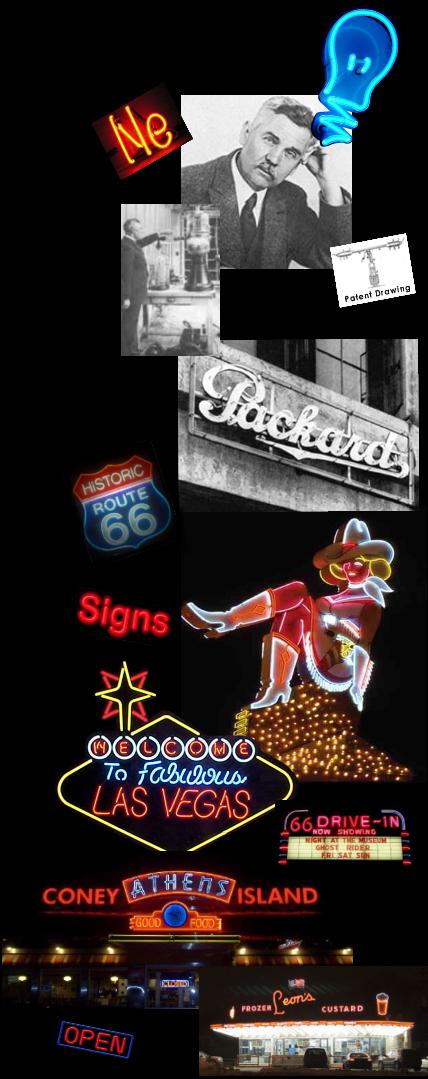
1902 Georges Claude - Develops the First Neon Lamp
Georges Claude was a French engineer, a chemist, inventor
and a pioneer in the development of neon lighting and signs.
His discoveries and inventions revolutionized neon technology.
He was the first person to apply an electrical discharge to a
sealed tube with neon as the gas creating the first neon lamp
(circa 1902).
Claude had developed the process of extracting neon from the
atmosphere by liquefying air, yielding very pure neon in useful
size quantities. Claude's also contributed to neon technology by
his invention of nonreactive electrodes large enough to handle the
ion bombardment without over heating or sputtering. His electrodes opens the way to a much longer life neon tube, and also with far less maintenance.
Eight years after Claude lights his first neon light he displayed his first neon lamp to the public in Paris.
December 11, 1910.
The first commercial neon sign was sold by Jaques Fonseque, Claude’s associate, in 1912 to a Paris barber.
1912
1923 Neon Comes to America
In 1923, Georges Claude introduces his neon signs to
the United States. He sells two neon signs to a Packard
Car dealership in Los Angeles. Earle C. Anthony purchased
the two signs reading"Packard" . Georges Claude charged
$24,000 for those two signs.
Neon signs quickly caught on as a popular fixture in
outdoor advertising in the U.S.. Visible even in daylight,
unique in its visual display, people loved the first neon
signs. The brilliant red illumination fascinated the public
and it was coined "liquid fire."
Neon became symbolic of America’s Inventiveness and
creativity. Through the 1920’s and 30’s extravagant neon
displays, and elaborate neon signs became more common
and these large scale signs began to dominate American down
towns from New York to California.
Las Vegas set the stage in the 40’s and 50’s with lavish
colorful and creative signs with impressive neon animations.
Border neon, and decorative architectural accents framed the
City streets.
1950’s-60’s Neon lights up Main Street
Neon signs dotted the landscape
reaching its hay day in the 50’s.
The diners and motels through out the
U.S. illuminated the night skies, lining
]our highways, and signing our businesses.
The 1960’s saw a steep decline in the use
of neon in our cities. Municipal sign codes
and public tastes changed. The use of neon
as “the” choice for an electric sign, was being
replaced with cheaper alternatives.
Georges Claude,
French Engineer, Chemist

< Previous 1 2 3 Next >
< Previous 1 2 3 Next >

